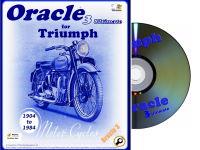
A new profile has been added to the list of Triumph motorcycle models on this site: The 3.5hp TT (1908-1913). After being beaten in the 1907 TT by Norton, Triumph built the world's first pure Grand Prix racer.
It used the 3.5HP engine that had been developed in 1906 as 453cc, then increased to 475cc in 1907. After Rem Fowler won the 1907 TT on a V-Twin Peugeot engine Norton, and Charlie Collier won the singles class on a Matchless, Mauritz Schulte convinced Siegfried Bettman that they needed a pure racer to compete against the competition. The result was the 499cc 3.5HP TT.
Whereas most motorcycles had pedals to help going up hills, the 3.5HP TT machine had ditched them - mainly to save weight but also to make a point that any machine with pedals was a motorised bicycle rather than a motorcycle and shouldn't be in the TT (though there was still a pedal to allow the machine to be started).
In its first outing in the 1908 TT, Jack Marshall won the singles class with an average speed of 40.5 mph and a fastest lap of 42.5 mph. A TT model, ridden by W.G. McMinnies, also beat a Matchless in a single-lap race at Brooklands in 1908 with a speed of 53mph. By 1910 there were eight 3.5HP TTs entered into the TT and all eight finished.
1911 saw the first race around the Mountain course and the Senior race was dominated by Indian twins, but Triumph was the first of the singles to come home. Then in 1912 Frank Haswell managed a second place finish behind a Scott water-cooled twin with a speed of 46.41 mph. At the Brooklands Six-hour race in 1913, Haswell finished in first place having covered 351 miles 1315 yards with an average speed of 59 mph - he was 53 miles ahead of the next machine to finish.
The differences between the TT model and the basic 3.5HP were numerous. As a racing machine it had a lowered frame along with the saddle and handlebars. It was also shorter to improve the steering. Anything to do with lighting had been removed again to save weight. The carburation was improved and there was an open exhaust to increase engine power. The result was a machine that could manage up to 70 mph! Because the Isle of Man roads were basically not much more than dirt tracks, the TT models all had high-tensile steel rims to cope with the stones and bumps.
Although later Roadster models had three 'gears', the TT racers kept to 2 with ratios of 4 and 6 to 1. The gear change was not easy. The rider had to dismount, get out his toolkit, adjust the engine pulley to the new setting, then either remove or add a section of the drive belt.












